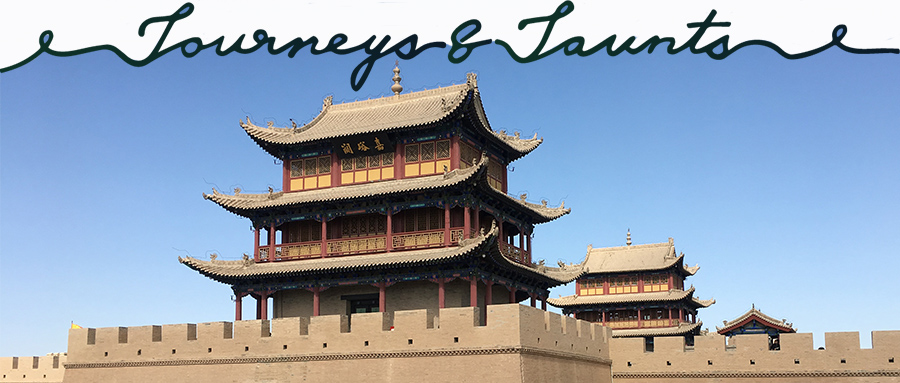If you have read the article Journey to Gansu – Mogao Caves, you should have deduced I’m a big fan of Gansu Province. Today’s article about Jiayuguan Fort will confirm this impression. The province has this wealth of history to share with us, from many dynasties and in many aspects of people’s lives. So, today, let’s have a look at the fort of Jiayuguan(or Jiayu Pass), Gansu’s most important piece of military history.

And also step into a tomb from the Wei and Jin dynasties to delve into burial rites and life of ordinary people from 1,700 years ago.

Together, these sights make for a perfect day trip from Jiayuguan town when you travel through Gansu Province.Let us first have a look at the fort.
The Fort at Jiayuguan
The fort, located about 6km southwest of the town of Jiayuguan, is the earliest frontier fortification structure of the Great Wall built in the Ming Dynasty. Jiayuguan and Shanhaiguan (near Qinhuangdao in Hebei province, about 400 km from Shenyang, or a good 4 hours by car) have an age-old rivalry about which pass is the most important one. It seems that Jiayuguan has won the battle, though, as it is called the “First and Greatest Pass under Heaven” (天下第一雄关in Chinese, tiān xià dì yī xióng guān in pinyin), whereas Shanhaiguan is ‘only’ the “First Pass under Heaven” (天下第一关in Chinese, tiān xià dì yī guān in pinyin).

As locals will proudly point out, Jiayuguan was built 9 years earlier than Shanhaiguan, and is also more intact and complete than its rival. There really should be no contest between the two…
When it was built at the narrowest point of the Hexi Corridor between two smallish mountains in 1372,Jiayuguan Fort was of strategic importance for protecting the Chinese empire against invading ‘barbarians’, mostly Mongol tribes. Because at that time, what is now Gansu province was on the very edge of China, anything further west did not belong to the realm.
Layout of the Fort
The fort at Jiayu Pass is shaped like a big trapeze of more than 33,000 square meters. If you were to circle the entire fort on its wall, you would have to walk for 733 meters, 11 meters above ground.

Visiting the fortification today is a bit confusing, as there are two gates (to the east side and to the west side of the pass), parts of the fort that are connected to the Great Wall, something called the ‘inner city’ and the ‘outer city’, as well as a moat.
Because the place is so big, I always get turned around trying to figure out when I am “inside” China and when I am in the “Western hinterlands”. That might be due to my abysmal sense of direction, though. You less directionally-challenged people will not have that problem, I’m sure. Mostly.
Life in the Garrison
The fort marked one of the points where one could leave the Chinese empire, and was therefore manned all year round. Not only were soldiers stationed there, but some imperial officials also had to stay on duty to administer to travelers wanting to enter or leave the Middle Kingdom. Much like today, anyone wishing to pass the border needed to show the correct papers and would get a red chop to prove everything was in order. They did not use fingerprint scanners or facial recognition software like today, though. At least I don’t think they did.

For these people stationed in the middle of nowhere, off-duty hours were undoubtedly boring at times. Therefore, they came up with all sorts of entertainment to make the time pass more quickly. One such means of alleviating boredom can be seen inside the ‘inner city’ part of the fort: A stage with changing plays, opera performances and musical acts helped the soldiers while away the hours.

Pastimes were not only of a frivolous nature, though. The GuandiTemple shows that many soldiers would pray for luck in battle and give homage to former general Guan Yu. For more information on him and another example of a Guandi Temple, read the article on General Zhang’s Mansion.
Legends and Stories Surrounding the Fort
Many old buildings have legends and stories surrounding them, and the fort at Jiayuguan is no exception. There are several myths around the construction period of the fort alone.
One is about how transporting the bricks needed for construction from the next town was labor-intensive and difficult, especially in winter. Apparently, some ingenious laborer decided to empty buckets of water onto the road, so that the carts loaded with bricks slid easily across the icy surface and everything could be transported in a much shorter time than anticipated.
A second story is about the difficulty of transporting the bricks from the carts to the actual construction site. A young boy herding goats saw the plight of the laborers having to carry the heavy bricks on their backs. So, he decided to conduct an experiment: he took off his belt, tied two single bricks to the ends, hung the belt over the back of one of his goats, smacked the animal and thus sent it up the hill to where the wall was built. Seeing this, the laborers emulated the young shepherd, and collectively, they were able to get all the bricks up the hill effortlessly and quickly.
The third and probably most famous story related to building the fort is about the meticulous planning beforehand. Supposedly, the official in charge of construction asked the architect to provide an estimate of how many bricks total they would need. The architect confidently said that 99,999 bricks would be needed. The official, afraid this estimate would be too low, asked the planner to revise it. Grudgingly, the architect complied, and added one more brick to his list of building materials. But, when construction was finished, one brick was left over. To this day, this extra brick is lying loosely on top of one of the gates, as a reminder of how important good planning is.

Yet another anecdote about the fort is about a pair of swallows who nested just outside the structure. These swallows, according to the legend, were a loving couple, spending all their time together.
But one day, when they flew through one of the gates of Jiayuguan Fort, the male, who flew behind the female, was crushed to death by the closing gate. The female swallow grieved for the death of her mate, and kept calling out to him, until she died as well from her sorrow.

From then on, travelers who passed through that same gate would knock on the wall of the fort, and interpret the echo they would hear as the swallow’s chirp. If you could hear that chirping sound, it meant that you would return safely from your journey.
The same went for generals setting out to war from Jiayuguan. Their families would knock on the wall to ensure the general and his entire army would come home safe and sound.
The museum
Jiayuguan Fort not only has impressive architecture and exciting legends in store for visitors, you can also find a well-curated museum depicting the history of the Great Wall and the Forton-site. There, interested guests can learn about the geography of the pass, about the construction of the fort, gain background information on trade through the Silk Road, and more.

There are detailed explanations in mostly good English on all aspects covered, and a multitude of recovered artefacts to admire. And a number of dioramas help us imagine what life at Jiayuguan Fort was like during the Ming dynasty.
Ticket Prices
Tickets to visit the fort (including the museum) cost 50 RMB per person. An audio guide costs 15 RMB, with an additional 100 RMB deposit you get back if you return the guide unharmed. They are available in Chinese or English and introduce 25 different spots around the fort. Small plaques on the walls with numbers and a little audio sign indicate there is a story behind that particular spot. The audio guide recording lasts about 50 minutes.
Does that sound like fun? Why don’t you contact us for a personalized itinerary to visit Gansu province? Or have us help you organized an individualized tour there? Journeys & Jaunts offers bespoke tours and itineraries for many Chinese destinations. Send a message into the WeChat account or an email to alina@journeysnjaunts.com.





